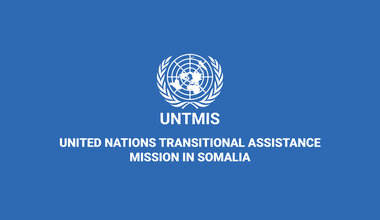Aid agencies access new areas to get a grip on humanitarian needs
Aid agencies, led by the United Nations Office for the Coordination of Humanitarian Affairs (OCHA), travelled to Maaxas in Hiraan Region on 28 May to assess the humanitarian situation on the ground. Maaxas is the fifth of ten newly accessible areas recovered from Al Shabaab control by the Somalia National Armed Forces and AMISOM two months ago to be assessed to determine urgent humanitarian needs and plan a response.
“Somalia is at risk of sliding back into an emergency,” said Ms. Edem Wosornu, OCHA Somalia’s acting Head of Office who led the mission to Maaxas. “Early warnings tell us that the country’s fragile food security situation is set to deteriorate in the coming months due to a combination of delayed rains, rising food prices and persistent conflict.”
The visit to Maaxas was part of the aid community’s efforts to assess newly accessible areas across the country, and deliver aid to communities in order to reverse the deteriorating humanitarian situation.
The assessment team met with local authorities and elders to get an overview of the needs of the communities in the area. The most urgent needs identified were food, healthcare, water, sanitation, education and livestock immunisation.
“Humanitarian needs here are immense,” reported Ms. Wosornu. “The main access to food for the community was from the capital of Mogadishu, but insecurity has resulted in the supply routes being blocked off. The only possible supply route is from Bossaso through Gaalkacyo and Belet Weyne which has resulted in doubling of prices for basic staples such rice, sugar, oil and flour, stretching coping mechanisms of already vulnerable families.”
With no health facilities in Maxaas, the nearest hospital or primary care access is Belet Weyne, some 125km away. There have been no vaccinations in Maxaas since 2007. There is only one bore hole and one spring. These water sources are used by people and animals and water purification tablets are desperately needed to curtail waterborne diseases. Fifty per cent of the towns 2,000 households are pastoralists. Because of the poor grazing, milk production is low and families have less food on their tables.
Maxaas is just one of the many towns in Somalia under these conditions. The parallels with the pre-famine period in 2010 are worrying, when the combination of shrinking access, a few failed rainy seasons and declining funds led to a devastating crisis. Aid agencies have called for urgent funding to prevent a repeat of the 2011 famine when 258,000 people lost their lives.
The Strategic Response Plan for Somalia has received less than 20% of the US$933 million needed to respond the Somalia’s vast humanitarian needs and programmes for water, sanitation and even basic health care are on the verge of closure. Aid agencies have just released an urgent appeal for $60 million dollars to keep the most vital lifesaving programmes, such as treating malnourished children and delivering aid, up and running just through the month of August, especially in newly accessible areas such as Maxaas.
 UN
UN



